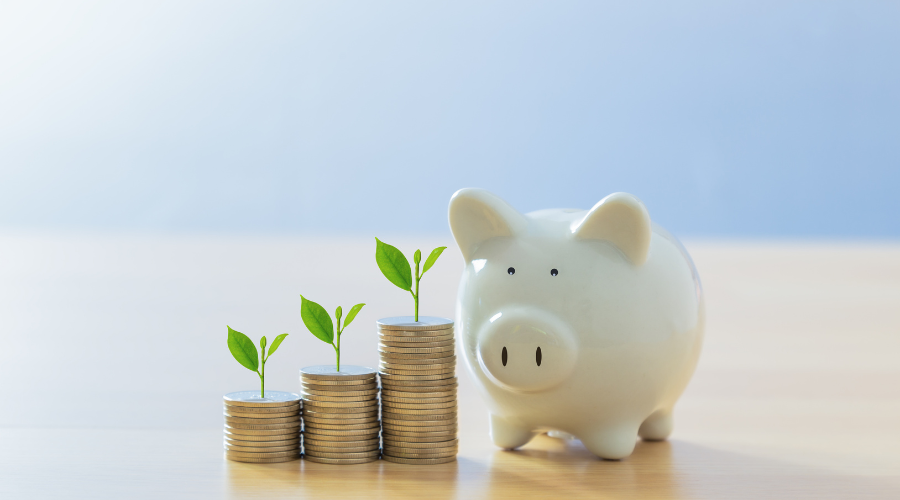How Does High-Yield Savings Work
September 27, 2024

Whether putting money away for a down payment on a car or just stashing cash for an emergency fund, consumers use savings accounts for ease of use and security. However, high-yield savings accounts (HYSAs) go even further by rewarding savers with more competitive rates.
Learn what makes these accounts so popular and how they can work to further savings goals. What Is a High-yield
Savings Account (HYSA)?
A high-yield savings account (HYSA) is a deposit account that pays a higher annual percentage yield (APY) than many standard savings accounts. The rate paid fluctuates depending on market conditions but can be as high as ten times the national average of standard savings or even higher. Like other savings accounts, HYSAs offer a secure way to store cash for short or long-term savings goals when placed on deposit at a bank that is a member of the FDIC. Deposits are insured up to at least $250,000 per depositor, per FDIC-insured bank, per ownership category.
How Does High-yield Savings Work?
High-yield savings accounts have many of the same features as standard savings accounts. They allow consumers to deposit as little or as much money as they want regularly, then withdraw when needed (subject to account limits.)
Money kept in the account earns interest daily, quarterly, annually, or according to another rate schedule. Terms vary by bank, but this interest accrues, meaning it is paid on the original amount put in by the deposit as well as on the interest earned from the previous earning period.
Here’s an example: A depositor puts $200 into a high-yield savings account with an annual percentage yield of 4%. The bank calculates interest to be paid annually. After a full year, the original $200 becomes $208.
At the end of the second year, if no additional money is deposited and the rate stays unchanged, that $208 becomes $216.34.
($208 balance x 0.04 interest rate = $8.32 interest earned. Add the $8.32 interest to the original $208 to get $216.34.)
In addition to the interest earned, HYSAs offer almost unlimited deposits but limit the number of withdrawals made during a month. Careful planning can help bank customers avoid fees and access money as needed for spending or transfers throughout the month.
Benefits of HYSAs
- FDIC insurance to protect balances of up to $250,000 000 per depositor, per FDIC-insured bank, per ownership category.
- Low risk.
- Easy access to cash through ATM, visit to the bank branch, or electronic transfer to internal and external accounts.
Disadvantages of HYSAs
- Potential fees for withdrawals above six per month or the limit set by the bank.
- Possible minimum balance requirements, with fees for going under the minimum.
- Lower earnings potential compared to other products and a possibility of not keeping up with inflation.
High-yield savings accounts are as liquid as other savings accounts, making it easy for consumers to access funds through online banking, mobile apps, and transfers. However, the number of withdrawals per month may be limited. For more on how to use a high-yield savings account, refer to the bank’s account rules, including any fees for exceeding the withdrawal limit.
Can You Ever Lose Your Money with a High-yield Savings Account?
High-yield savings accounts are generally FDIC-insured, so they are protected up to $250,000 per depositor, per insured bank. Some conditions may affect how much the account earns in interest, however, including:
- Variable interest rate, which goes up and down with the market and determines the annual percentage yield of the account.
- Fees, which may be assessed for making too many withdrawals in a month or not keeping the account balance above the minimum (if required).
While both factors may prevent an account balance from growing quickly, HYSAs are generally considered safer.
How To Choose a High-yield Savings Account
Picking the right high-yield savings account depends on the individual consumer's goals, and different banks or credit unions offer different account features.
Variables to consider include:
- Interest rate (APY): Look for an account with a competitive rate and compounding schedule to help you earn faster over time.
- Fees: Factor in the cost of maintenance fees, withdrawal fees, or minimum balance fees. If possible, aim for an account that eliminates most fees.
- Minimum balance requirements: Ensure you can meet the minimum requirements without being assessed fees for going under.
- Accessibility: Know how to get the money, how long it takes, and if you can access it on the weekends or holidays.
- Customer service: Many online banks don’t have physical bank branches and can’t assist with face-to-face meetings.
Alternatives To HYSAs
While high-yield savings accounts are the right choice for many, they may not work in every situation. Other common banking services include:
- Certificates of Deposit (CDs) may offer even higher rates than HYSAs, but depositors don’t have access to funds until the CD matures.
- Money market accounts (MMAs) offer a balance of high interest rates and check-writing services, combinging the best of savings and checking accounts.
How High-yield Savings Accounts Fit into a Financial Plan
It’s common for consumers to have a checking and savings account. Moving some money to a high-yield savings account adds even more benefits and can boost interest earnings in times of high market rates.
Talk to a Centier representative today to see how a HYSA can help you save for your important goals.


